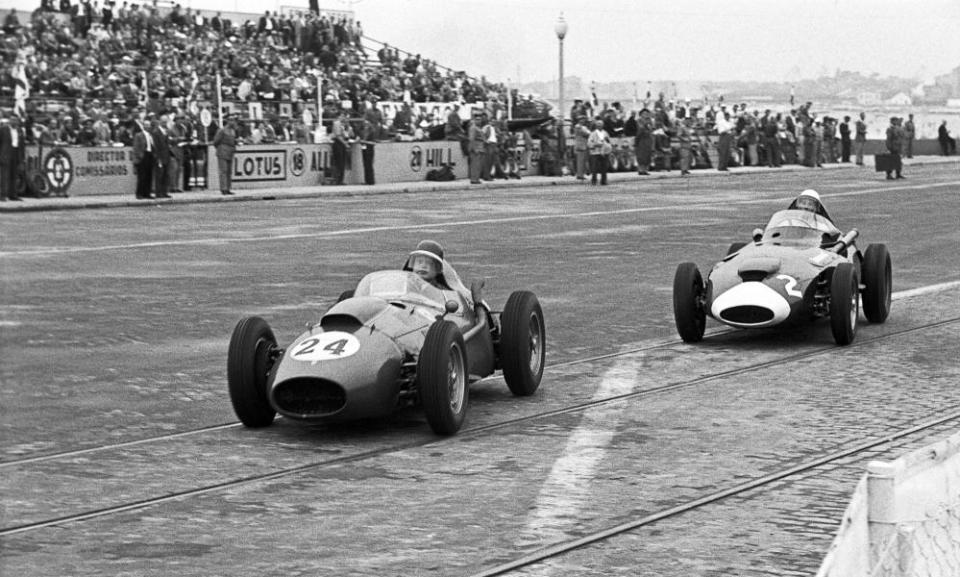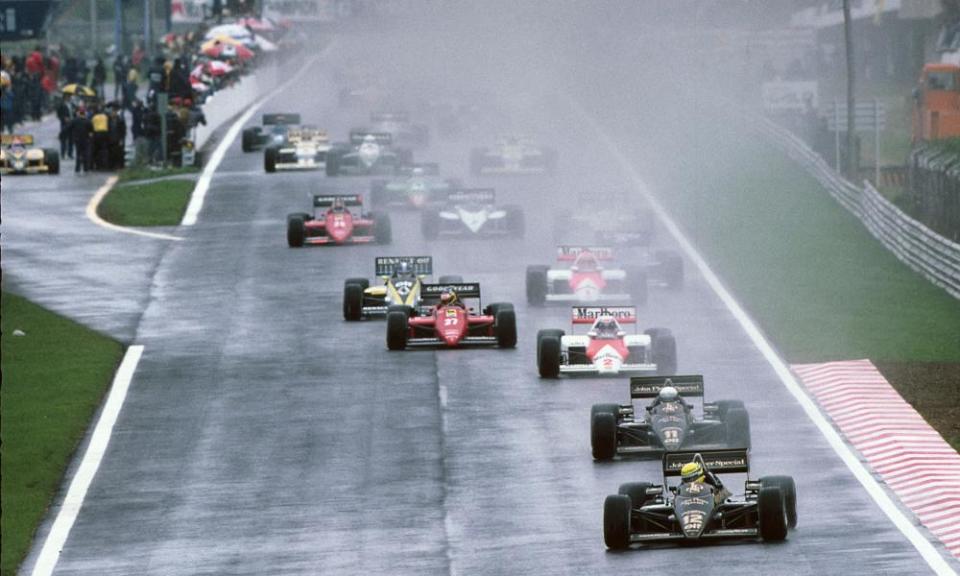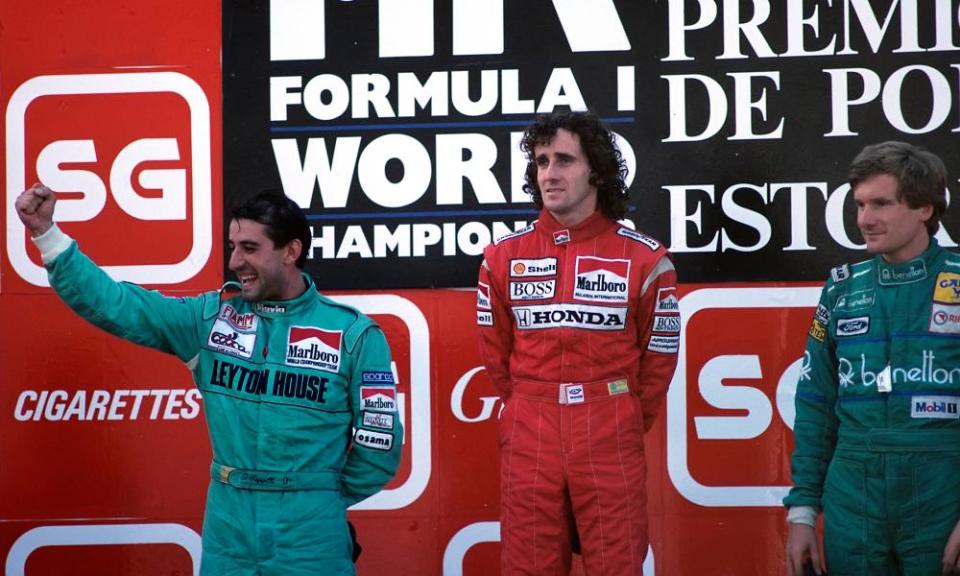Great Portuguese GPs: from Porto's pavements to Senna's crowning F1 win
Boavista 1958 – A pavement pickle
The Boavista street circuit in Porto hosted the first Portuguese F1 grand prix, posing a tough challenge over tramlines, drains and cobblestones, requiring bravery and finesse. It was a task made all the more tricky by a slippery track but Stirling Moss had its measure in the Vanwall. He and Mike Hawthorn, rivals for the title in this ninth of 11 meetings, tussled for the lead and swiftly opened a gap on the field. Moss was masterful past the pillar boxes and lamp posts and soon held the advantage, while Hawthorn looked to hold second with the brakes on his Ferrari not proving up to the task. A spin on the final lap almost ended his hopes. With the car stalled he leapt out to push-start it, but in doing so rejoined against the direction of the circuit and was disqualified. Moss, who had witnessed the incident, went to the officials making the case that Hawthorn had driven on the pavement not the track when he was going the wrong way. They accepted his argument and Hawthorn was allowed to keep his second place. At the end of the season Hawthorn beat Moss to the title by a single point. Moss never won the championship but his credentials as a gentleman and ambassador for fair play have never been in doubt.

Estoril 1984 – The tightest title
Related: Hamilton unhappy at Black Lives Matter critic Petrov's Portuguese F1 GP role
After a 24-year gap F1 returned to Portugal, at the Estoril circuit when it hosted the championship decider in 1984. The battle could not have been more intense; McLaren teammates Niki Lauda and Alain Prost were separated by only three and a half points, with Lauda in front aiming for his third title almost a decade after his first. Securing it was no easy task. An unusual error in qualifying had left him 11th on the grid, with Prost on the front row. If the Frenchman won Lauda had to claim second to take the overall champioship. He had even more work to do however when a turbo issue prevented him from making a charge early in the race. When he did, he made his move with aplomb, clinically moving up to third by the midway point. Prost however was leading and Lauda had a 37-second deficit to Nigel Mansell in second. The turbo problem still plagued him and as the laps ticked away with nail-biting intensity, his efforts seemed for naught until fortune favoured the Austrian. Mansell suffered a brake problem, spun out and retired with 18 laps to go. Lauda took second and the title by the smallest margin in the sport’s history – half a point. He gave his all in the race and felt it was his greatest championship, more satisfying even than his comeback to win in 1977 after his horrific accident the previous year.

Estoril 1985 – Senna’s greatest triumph
In only his second season in F1 and driving for Lotus, Ayrton Senna issued definitive notice of his extraordinary talent by taking his debut F1 win with a display of breathtaking brilliance. The Brazilian had taken his first pole in the dry but the race was an entirely different affair in teeming rain, with track conditions treacherous. Senna more than had their measure; even opening with conservative care he had put more than two seconds on his teammate Elio de Angelis on the opening lap. As the race developed and the field grew more nervous and tentative in the torrents sloshing across the circuit, Senna found grip and pace where there was seemingly none. He was more than half a minute up by the mid-point in conditions so bad even he believed the race should have been stopped. Yet on they raced and his masterclass continued as the opposition fell away. Only nine of 26 runners remained at the flag by which point Senna had lapped the entire field bar Michele Alboreto’s Ferrari which was a full minute back. In a career marked by some exceptional performances, Senna counted Portugal as his finest moment.

Estoril 1988 – Day of the underdog
During a season in which McLaren were almost unbeatable, with Alain Prost and Senna taking 15 wins from 16 races in the mighty MP4-4, Portugal threw up some real drama. Ivan Capelli, in his second full season in F1, was an outsider in the Leyton House March but haring round Estoril in Adrian Newey’s first F1 car, the hugely impressive 881, the Italian was entirely unintimidated. In front the race was notable enough for the moment Senna almost squeezed Prost into the pit wall and their relationship became clearly acrimonious. However, having qualified in third behind the McLarens, Capelli refused to be left out of the drama and with Senna struggling for grip, passed him for second on lap 22. With Gerhard Berger on Capelli’s tail and Prost having to manage his fuel the race was alive with possibilities until finally Prost felt confident he had enough juice to eke out a better pace to the flag, while Capelli, fearing his engine might yet fail, settled for a superb second, his best finish to date. It was, alongside leading the French GP for all but three laps in 1990, one of Capelli’s finest performances and brought Estoril alive.

Estoril 1996 – Villeneuve makes his mark

Portugal’s final race until this year gave Jacques Villeneuve the platform to make an unforgettable impression. It was the Canadian’s rookie season and he had already justified Williams’s confidence in signing him. Facing talent that included Michael Schumacher, the reigning and double world champion, Villeneuve was magnificent. Dropped from second to fourth off the line as his teammate, Damon Hill, took a strong lead, Villeneuve set off after Schumacher. He caught him going in to the long right hander that led onto the straight – a spot where overtaking was considered unthinkable. Certainly Schumacher was of that opinion; he had to briefly lift because of the ponderously slow moving Giovanni Lavaggi and Villeneuve pounced round the outside. It was a move he had considered possible from his experience on ovals in Indycar but had been dismissed as unfeasible by his team. Schumacher looked behind him only to find Villeneuve already alongside and as the cars squeezed perilously close the Canadian did not flinch and emerged ahead. After what had seemed like an age the crowd collectively exhaled with raucous cheers. Villeneuve went on to chase down Hill and took a marvellous win.
Watch: 6 Minute Full Body Strength Workout


